List of Authors
>>About this blog
Recent blog post
|
[Sam]
May 25, 2015 18:00
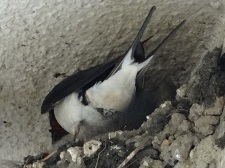 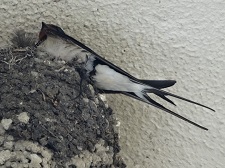
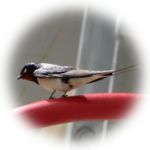 A swallow in Ginza. A swallow in Ginza.
Swallows flew over the sea several thousand kilometers from Southeast Asia, a wintering area, to Matsuya East Building, one of the three nesting sites confirmed last year.
Originally, it should have nested in the natural environment, but from some point on, swallows coming to Japan are said to not nest except for constantly popular artificial buildings, and have been involved with human lives. Wild birds that have come.
Swallow is migratory bird (summer bird) of the sparrow family.
The head and back are glossy indigo black, the lower surface is white, the forehead and throat are reddish brown, and the chest is thin black belt.
It is said that the first row of the wings stretches long, has excellent flightability, and the tail is a so-called "swan tail shape" with a deep cut, and males tend to be longer than females and narrower.
It preys on insects that live while flying in the air and descends the surface of the water to drink water.
The legs are short and unsuitable for walking, and the structure of the body specializing in flying.
A bowl-shaped nest is built by mixing mud, hay and saliva.
Female and male joint work from nesting to nesting of chicks.
It is said that old nests are often repaired and used.
It hatches in 2 weeks after incubating, and for another 3 weeks, the parent swallow carries food.
In a harsh natural environment where the probability of survival is not necessarily high, the parent bird shows up close and raising chicks hard is impressive.
The season of nesting soon.
Next season, we will welcome the swallows warmly, and we would like to maintain the gentleness of the city that can be watched.
[Sam]
May 24, 2015 18:00
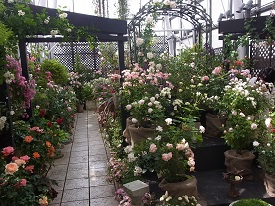 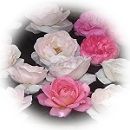 The annual "Rose Garden 2015" has begun at the salon space "Royal Room" with terrace on the 10th floor of FANCL Ginza Square (Ginza 5). The annual "Rose Garden 2015" has begun at the salon space "Royal Room" with terrace on the 10th floor of FANCL Ginza Square (Ginza 5).
This time, the aerial garden is filled with beautiful roses under the theme of "bienvenue-Toward a happy healing garden".
Date: May 22-29 (11:30-18:30)
During the period, there are also "Rose Consultation" by Musashino Rose Association members and "Dole Garden Experience" by Seiko Horie.
On May 24 (Sun), a rose talk show with fragrance, "Enchanted by fragrant roses" by rose researcher Hideko Ishiguro, is organized.
During the period, a photo contest for “Scenery with Roses” in the museum is also being held.
This year again, in the middle of Ginza, the 40m above the ground petit garden has a sweet scent of roses that attracts people and does not stop, and various flowers grown with great care will entertain the eyes of visitors.
    
    
    
[Sam]
May 9, 2015 18:42
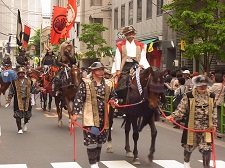 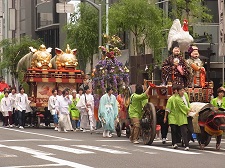
The annual Kanda Festival is held once every two years. This time, it is becoming even more exciting as the “400th Anniversary Festival”, which will celebrate the 400th anniversary of Kanda Shrine in 2016. (May 7-15)
It seems that Kanda festival was mainly composed of the magnificent floats of the town of shrine parishioner, as well as dance platforms, towing objects, and disguise lines, which incorporate a variety of popular cultural arts (Noh, Joruri Kabuki, Dance, Sound Music, Sosogami, Legends, etc.).
In the Meiji era, the opening of trams and laying of telegraph poles hindered the passage of floats, and instead of floats, carrying of miniature shrines came to be called the "imperial procession Festival" and changed its name to the "Shinko Festival" after the war.
In the Heisei era, the retrospective of history triggered the revival of the "Appendix Festival". The former towing items such as "Large Catfish and Keystones", "Oeyama Kaijin", "Hanasaki or grandfather", "Urashima Taro", etc. are restored. This year's "Attached Festival" held on May 9th included a new character such as "Neri = floats" in the two towns of the Mikumano Shrine Festival in Shizuoka Prefecture, where the style of the floats of the Tenka Festival is transmitted, and the equestrian warrior of the brave Soma Nomaoi, the character of Kanda-jinja Shrine "Mikoshi" and the sacred horse "Akari-chan".
15:00 Departing from Arima Elementary School
16:15 Koamicho Children's Park
16:30 Nihonbashi Sanzen Echizen
17:25 Akihabara Electric Town
18:15 Akira Kanda Kamitsuki
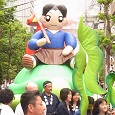 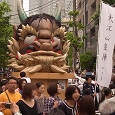 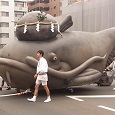 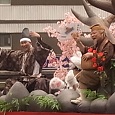
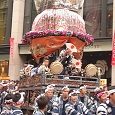 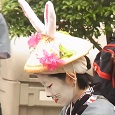 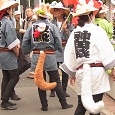 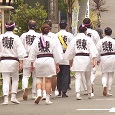
[Sam]
May 9, 2015 09:00
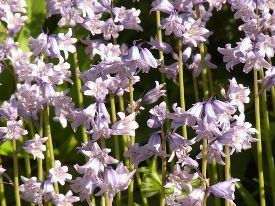 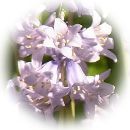 May 6th is "Ritsu Summer" in twenty-four season old calendar. May 6th is "Ritsu Summer" in twenty-four season old calendar.
When the sutra of the sun reaches 45 degrees, it is also called "summer stand" or "summer comes".
The young leaves of the trees in the "Harumi Triton Garden" are lush, and it is an attractive season.
The annual "Mini Garden Guide Tour" takes a walk around the park with the guidance of a green advisor at the hotel pocket plaza "Flowers, Water and Trees".
This month, it was held on the 7th under the theme of "Spring Color". (12:30~12:50 14:30~15:20)
In the "Flower Terrace", the red color of "Venivana Tochinoki", the white color of "Yabudemari" Pink Beauty "" (the so-called "ornamental flower" which began to bloom is white and gradually turns pale pink as it blooms), and the pale yellow color of "Mokkobara".
This time, I learned a lot about seasonal flowers through the Plants Walk, but I took up the situation of Aosji Ageha, which was caught on the spot.
"Shirakanpanorata" at the beginning, which decorates the foot of a corner of the flower terrace.
Also known as Tsurigane narcissus, Spanish bluebell.
It is a perennial plant of the genus Hyassin Soides (also classified as the genus Lilyaceae), and is home to many pretty flowers of light purple bell-shaped bell-shaped.
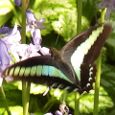 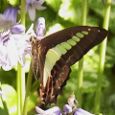 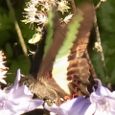 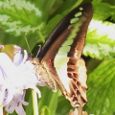
On the other hand, "Aosji Ageha".
In recent years, the larvae are one of the most popular species in the city center, as they eat camphor trees such as Cinnamomum camphora, Japanese bay tree, Nikkei and Yabunnikkei.
Adults are said to occur 2-4 times a year from May to October.
It's time to listen to the "season news" of the "old world swallowtail butterfly Hatsumi" observed by the meteorological observatory.
The wings are black, and the bands with bright blue-green, translucent window-like patterns on the front and rear wings are eye-catching.
The movement is fast, flying around trees and flowers.
"swallowtail butterfly" is rare and usually has the habit of closing the wings and resting.
It is nailed for a short time by trembling the wings in small increments.
[Sam]
May 3, 2015 09:00
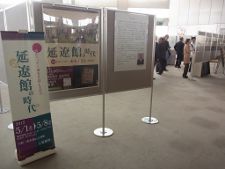 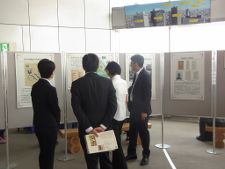
 From May 1 (Fri) to 8 (Fri) (closed on the 7th), the Tokyo Metropolitan Archives Panel Exhibition "The Age of the Yan Liao Museum-Meiji Nippon Hospitality Beginning-" is being held at the Tokyo Metropolitan Government South Observation Room. From May 1 (Fri) to 8 (Fri) (closed on the 7th), the Tokyo Metropolitan Archives Panel Exhibition "The Age of the Yan Liao Museum-Meiji Nippon Hospitality Beginning-" is being held at the Tokyo Metropolitan Government South Observation Room.
In preparation for the 2020 Tokyo Olympic and Paralympic Games, the restoration of Yan Liao Museum, the first guest facility in modern Japan, is scheduled to be held at Hamarikyu Onshi Garden as a facility to entertain overseas customers. With this opportunity, the Tokyo Metropolitan Archives has once again started a survey of materials by related organizations in addition to the collections, and the exhibition of the Yong Liao Museum, which has not been elucidated until now.
<Exhibition Composition>
Ⅰ Ishimuro, a naval facility in Hamagoten and late Tokugawa shogunate
Ⅱ Meiji Japan's foreign guest "Hospitality"
Ⅲ "Hospitality" at Western-style dinner and dinner parties
Ⅳ From the Ministry of Foreign Affairs of Yang Liao to the Imperial Household
In 1866 (1866), Hamagoten was under the jurisdiction of the Shogunate Navy, and the following year, a wooden frame stone building called "Ishimuro" was built as a navy government building and training facility. In 1869 (1869), when U.K. Prince Edinburgh as a state guest, he hurriedly repaired the stone room, and the first guest facility in modern Japan, named Yan Liao Pavilion, was born. In 1870 (1870), the former Hamagoten Ichien was under the jurisdiction of the Imperial Household Ministry, but only the Yan Liao Museum is under the jurisdiction of the Ministry of Foreign Affairs. In 1883 (1883), the Kannarukan was completed and the status of the front stage of the event hosted by the Ministry of Foreign Affairs was handed over, but in 1884 (1884), the first Tenran sumo wrestling was held, and for the sumo world, which had been stagnant since the Meiji era, It seems to have been handed down that it was a turning point for life. In the same year, he moved to the Ministry of Internal Affairs and Communications. It highlights the Yan Liao Pavilion, which has been widely used as a major stage for diplomatic service and as a venue for meetings, feasts and events organized by government officials until its demolition in 1890.
We look forward to the day when this Historic buildings is restored in the nationally designated special scenic spot and historic site Hamarikyu Onshi Garden.
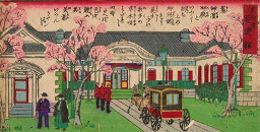 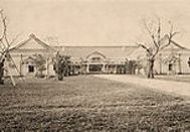
[Sam]
May 2, 2015 09:00
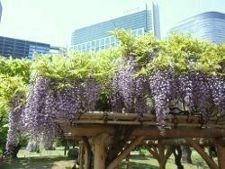 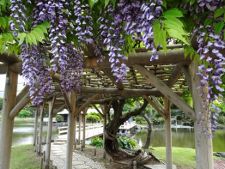
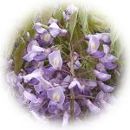 May when the wind is fragrant. We have reached a refreshing season with fresh green dazzling. May when the wind is fragrant. We have reached a refreshing season with fresh green dazzling.
In front of the "Yon Liaokan Ruins" in the Hamarikyu Onshi Garden and the "Oden Bridge" in the "Tide Pond", the wisteria trellis of the "Small-shaped Island" in the middle of the Oden Bridge are colored with light purple flowers. You.
During this period, the fence is specially removed and released so that the wisteria trellis at the site of the Yan Liao Museum can be seen up close.
Fuji is a vine deciduous leaf Kimoto of the legume family.
The appearance of the "wisteria purple" flower spikes hanging down on the shelf is lustrous, fragrant, and the appearance of blooming in the wind swaying and blooming in the wind as described as "Fujinami" is also a moving flower , Has been popular since ancient times.
There are Nodafuji and Yamafuji in endemic species, Japan, and in general, Fuji seems to refer to Nodafuji.
<Noda Fuji> The spikes are long, and the vine is winding (from the top) right winding.
<Yamafuji Temple> The spikes are short, and the vine is winding (from the top) left winding.
Also known as "Capitan (Hanami Short) Fuji"
Flower colors include white, peach, and light red color in addition to the symbol color mauve color.
In addition, "Kingsari" called "Kibanafuji" is a separate genus of the legume family, Kingsari.
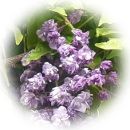 According to the staff of the garden, most of the park is Yamafuji Temple, but the wisteria trellis at the northern end of the "Oden Bridge" is a rare Noda Fuji type "Yae Kuroryu Fuji (Yae Kokuryu Fuji) "is planted. According to the staff of the garden, most of the park is Yamafuji Temple, but the wisteria trellis at the northern end of the "Oden Bridge" is a rare Noda Fuji type "Yae Kuroryu Fuji (Yae Kokuryu Fuji) "is planted.
Also known as "Peony Fuji".
The stamen is remarkably peony, and it is said to be a unique variety that becomes "peony bloom".
1
|
Links
|
A swallow in Ginza.



 The annual "Rose Garden 2015" has begun at the salon space "Royal Room" with terrace on the 10th floor of FANCL Ginza Square (Ginza 5).
The annual "Rose Garden 2015" has begun at the salon space "Royal Room" with terrace on the 10th floor of FANCL Ginza Square (Ginza 5).





































